Below you can download excerpts of our past reports. You can subscribe to receive the full report, respondent data and year-over-year trending. For more information on what we cover and how to sign up just fill out the contact form at the bottom of this page.
Click here to subscribe to our free newsletter: Hub Intel

The growing role of gaming in consumers’ entertainment lives
LEARN MOREThe expansive gaming world continues to grow in 2025, with studios more invested than ever in global gaming IP franchises and opportunities to reach consumers via new consoles (Nintendo Switch 2) and platforms (e.g. Netflix mobile games). Franchises like Super Mario Bros and Minecraft are two of the industry’s biggest recent movie blockbusters, and properties like The Last of Us and Fallout have broadened their fan bases with successful TV series. While more than a third of Gen Z’s entertainment screen time is spent gaming, the growth of gaming among older consumers and women continues to redefine the gamer profile.
2025’s Gaming 360 study will continue to explore how gaming platforms and behaviors are changing, with data trends reaching back to Hub’s first wave of this study in 2019. This study will reveal opportunities for both studios and advertisers, as gaming continues to impact consumer leisure time.
Source: Interviews with 2,549 U.S. consumers 16-74
Click here to subscribe to our free newsletter: Hub Intel
Get a Free Excerpt
The evolution of sports fans and sports media
LEARN MOREWhat’s the Score? is Hub’s ongoing deep dive into how sports fans watch content across platforms—from broadcast to streaming—and what they value most. It explores not just where fans watch, but which types of content matter most.
Since launching in January 2024, the sports media landscape has shifted rapidly. Streaming giants are reshaping access: Amazon now carries Thursday and Monday Night Football, streams NBA and WNBA games, and Netflix has added NFL games on Christmas Day. Paramount+ streams top soccer like the Champions League and NWSL, while DAZN holds international rights to FIFA and other global leagues.
Wave 4, What’s the Score? is capturing how fans are adapting to these changes. More specifically, What’s the Score? examines how fans engage with sports across different viewing platforms. How “sticky” is exclusive content when it comes to attracting or retaining subscribers? Do these effects vary by major U.S. sport? Is fragmentation diluting the fan experience—or are new sports bundles helping to ease the frustration?
Each wave also explores timely topics shaping the sports landscape. In Wave 4, we delve into:
Source: Interviews with 3,802 U.S. Sports Fans with broadband access age 13-74
Get a Free Excerpt
Which providers do consumers turn to *first* when they want to watch TV?
LEARN MOREHub’s annual Decoding the Default study will continue to track the services, content and devices that viewers turn to first when they’re ready to watch TV content.
With the media landscape undergoing additional structural shifts, including the spin-off of NBCUniversal’s Versant and Warner Bros. Discovery’s breakup into separate streaming and linear businesses, viewers are increasingly faced with a more fragmented content ecosystem. In parallel, the continued rise of FAST channels such as Pluto TV and Tubi is redefining value propositions for viewers who are cost-conscious or overwhelmed by too many paid subscriptions.
In this increasingly complex environment, Decoding the Default continues to explore the first-stop behaviors that define the viewer’s journey. A viewer’s default platform is often their “home base” for viewing, significantly influencing overall frequency of use, depth of engagement, and even subscription retention.
This year’s study will deliver timely insights to help content providers, streamers, and distributors understand what earns and sustains “default” status, offering a strategic lens into which platforms are gaining share of mind, and which are at risk of being deprioritized in a market that is constantly in motion.
Source: Interviews with 1,600 U.S. TV viewers with broadband access age 16-74
Click here to subscribe to our free newsletter: Hub Intel
Get a Free Excerpt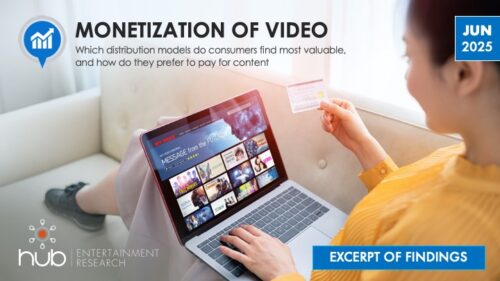
Which distribution models do consumers find most valuable, and how do they prefer to pay for content
LEARN MOREMid-year 2025 has brought increasing economic concerns, with consumers looking more closely at their pocketbooks as inflation and tariffs will potentially impact all aspects of spending, including entertainment-related spend. TV services, both MVPDs and streamers, have introduced new bundles and service packages that offer price discounts and targeted packages to enhance value and reduce churn. How much are consumers scrutinizing those TV services, and how are they prioritizing what’s worth paying for or not?
As users have settled into using a broad mix of both free and paid services, some service loyalties are deepening while others remain occasional services that users are willing to dip in and out of with less regularity. As free ad-supported services (like YouTube, Tubi) have gained in popularity, is the value of paid services diminishing or do they still offer a valuable premium experience? Have efforts to reduce password sharing increased loyalty among paying subscribers, or alienated them from ever paying at all?
Hub’s Monetizing Video study tracks how consumers have been navigating paid TV services since 2018. The study explores how much consumers currently pay (and are willing to pay) for TV services, and which features offer the best value.
Findings from this study will inform companies about what makes one provider or service have greater perceived value to consumers than others.
Source: Interviews with 1,600 U.S. TV viewers with broadband access age 16-74
Click here to subscribe to our free newsletter: Hub Intel
Get a Free Excerpt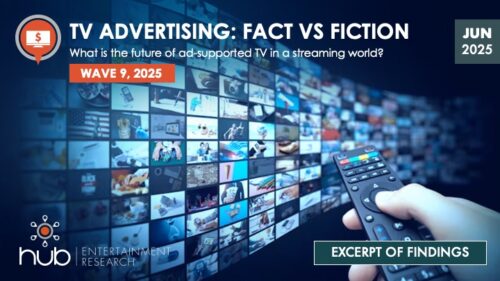
What is the future of ad-supported TV in a streaming world?
LEARN MOREStreaming has fundamentally reshaped the TV landscape, but one constant remains: the importance of advertising. As traditional TV viewership continues to decline and streaming, both free and paid, grows share of viewing, advertisers and programmers alike are continually refining and revisiting monetization strategies, with advertising as a core component.
Our TV Advertising: Facts vs. Fiction study has continually shown that viewers are increasingly open to advertising, especially when ads align with their viewing preferences and offer them cost savings. And, we’ve consistently seen that a positive ad experience, with reasonable loads of relevant commercials, is linked with increased attention and ultimately better value for advertiser, service, and viewer. So, what are the factors that enhance – or detract from – viewers’ ad experience?
In this ninth wave of TV Advertising – Fact vs. Fiction, we will continue to track use, viewing behaviors, and perceptions of ad-supported TV while exploring the following key areas:
The goal of the study is to help streaming services, media agencies, advertisers, and distributors better understand how to present advertising that enhances viewers’ engagement and satisfaction with the streaming video experience.
Source: Interviews with 3,004 US TV Viewers age 14-74
Click here to subscribe to our free newsletter: Hub Intel
Get a Free Excerpt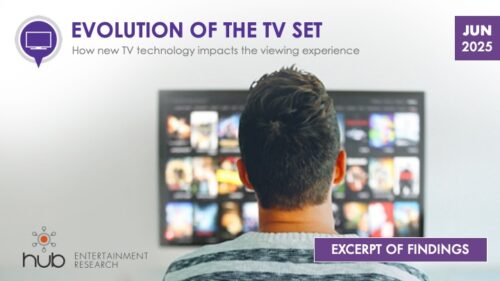
How new TV technology impacts the viewing experience
LEARN MOREWith connected TVs at the center of the home entertainment universe, viewing time and engagement with those TVs has continued to grow. Since last year, streaming video’s share of viewing via connected TVs increased 6 percentage points to 43.5% in February 2025 (according to Nielsen’s Gauge). Viewers are spending more time than ever with these connected TV sets, where choices are infinite but the user experience is as varied as ever. Different TV operating systems deliver distinct user interfaces that users must navigate to get to the content they love – from the moment they turn on their set, to their efforts to find specific apps and shows, and how they are exposed to advertising and promotions throughout. The absence of a uniform experience creates challenges for programmers to understand just how easily consumers are getting what they want in the easiest and most satisfying way possible.
The Evolution of the TV set has tracked current TV set experiences and preferences since 2019, bringing clarity to how viewers are navigating TV features and functions, how they find content, and how that impacts their overall TV attitudes. This study will continue to guide all stakeholders in the “TV value chain” (device manufacturers, content producers, content distributors, and advertising sellers and buyers) to improve the consumer TV experience and optimize TV features that add the most value.
Source: Interviews with 2,528 U.S. consumers 16-74
Click here to subscribe to our free newsletter: Hub Intel
Get a Free Excerpt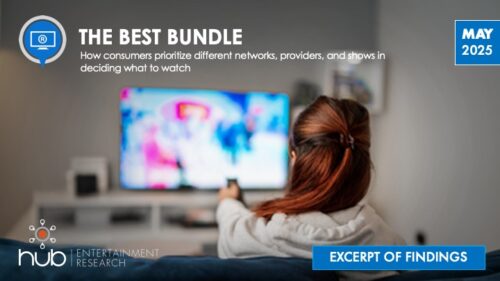
How consumers prioritize different networks, providers, and shows in deciding what to watch
LEARN MORE2024 saw a wave of new streaming bundle announcements that have captured consumers attention: Disney+, Hulu and Max for $16.99 (w/ ads), discounted offers through Amazon Channels (like Max/Starz for $20.99 (no ads), and other sports-focused bundles (e.g. DirecTV’s MySports), to name just a few. As streaming prices have continued to rise for consumers, the power of lower-priced bundles and consolidated billing is an attraction that helps acquire new subscribers and keep existing subscribers stickier over time. The growing popularity of free video services like YouTube, Tubi and Pluto are also satisfying price-sensitive viewers with additional content that delivers well on niche interests and genres. Above all, as viewers struggle to find desired content across so many services, the power of bundles to help integrate content and streamline search and discovery is a value-add that viewers crave.
Hub’s annual Best Bundle study will continue to identify how TV consumers are prioritizing different combinations of content and navigating this complicated landscape. What mix of video services best meet their viewing needs? What are the most common combinations of platforms, including configurations of linear vs streaming services, ad-free vs. ad-supported and other free services? We will also pay particular attention to the impact of sports (e.g. NFL on Netflix, Tubi) and live events in driving interest in different services.
Source: Interviews with 1,600 U.S. TV viewers with broadband access age 16-74
Click here to subscribe to our free newsletter: Hub Intel
Get a Free Excerpt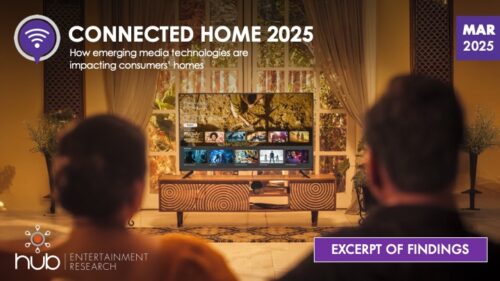
How emerging media technologies are impacting consumers’ homes
LEARN MORE2025 marks the sixth year of Hub’s “Connected Home” tracking study. This research provides a broad look at the technology and devices in US households, as well as intentions to purchase new technology in the future. Manufacturers are shifting into high gear with devices and applications to serve consumers that are “always connected” – to each other, and to entertainment content across a variety of platforms.
This year’s survey will capture the devices and technology consumers own, and which play the greatest role in their interaction with entertainment content: consuming it, as well as controlling or discovering it. We’ll also look at new entertainment tech just announced at CES to see which are most likely to “move the needle” in the coming year.
As part of the Entertainment & Technology Tracker series, this report will also include quarterly tracking questions about the home media technology landscape.
Source: Interviews with 5,001 U.S. consumers 16-74
Click here to subscribe to our free newsletter: Hub Intel
Get a Free Excerpt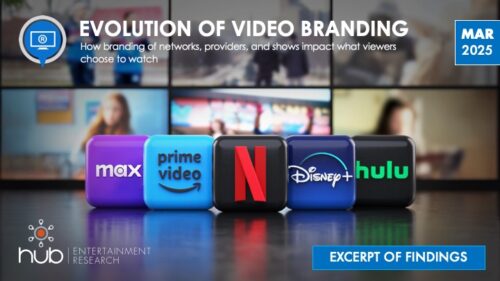
How branding of networks, providers, and shows impact what viewers choose to watch
LEARN MORESince 2019, Hub’s Evolution of Video Branding study has tracked awareness and perceptions of brands across the TV ecosystem.
As we begin 2025, consumers still face a fragmented landscape of myriad streaming services and places to watch favorite TV shows, movies, sports and other programming. 2024 saw big growth in FAST services, new streaming bundles, and broader licensing of content across services as the industry faces pressure to improve profits. As major streaming services push to broaden their content offerings, consumers must choose which services offer the most desirable programming at the right price.
In meeting the needs of consumers, providers will benefit most from driving awareness and interest in the attributes that make their services unique and most valuable. Highlighting what makes their brands stand out from other services will be the key to their success: exclusive content, library content, live sports, unique bundles, tailored subscription tiers, and more.
2025’s Evolution of Video Branding study will continue to track not just awareness of different platforms and streaming services, but also which service or brand attributes have had the strongest impact on consumers’ perceptions. Where available, trends with prior waves of the report will be shown.
Source: Interviews with 1,601 U.S. TV viewers with broadband access age 16-74
Click here to subscribe to our free newsletter: Hub Intel
Get a Free Excerpt
The evolution of sports fans and sports media
LEARN MOREThe media industry is experiencing drastic disruption. Consumer behavior is becoming much more unpredictable due to the introduction of streamers, user-generated content, and many other media to consume content.
However, it is a common belief that one content genre continues to drive passion and demand: sports.
What’s the Score? is Hub’s new exploration of how fans and consumers value sports – including sports-adjacent content. It is clear that live sports have become the primary leverage point between broadcasters and distributors, guiding decisions of when to black out content during negotiations. And although live games are typically the main appeal, leagues & broadcasters are continually innovating to reach broader audiences and maintain the value. But what are the interest levels across alternative broadcasts, sports betting, podcasts, etc.?
More specifically, What’s the Score? aims to understand sports fandom vis-a-vis consumption platforms. How ‘sticky’ is exclusive content on a platform for subscribers’ or viewers’ retention or acquisition? How does it differ by the level of avidity per fan by league? Does fragmentation impact the overall fan experience?
As rights continue to shift across broadcast, pay TV, streaming, and direct-to-consumer, it is becoming increasingly important to understand the value of sports content for all stakeholders.
Hub’s research will provide anyone who creates, distributes, and advertises on sports content with a deeper, more nuanced understanding of how much sports matter to your audience, and why.
Source: Interviews with 3,753 U.S. Sports Fans with broadband access age 13-74
Get a Free Excerpt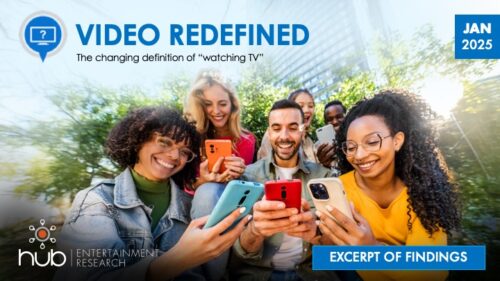
The changing definition of “watching TV”
LEARN MOREHub’s annual Video Redefined study puts TV and movie viewing in perspective with the increasingly powerful category of non-premium video, aka “social video” and other short-form or user-generated content. Once considered a supplemental category of viewing, social video now comprises about a quarter of all video viewing time at places like YouTube and TikTok. With only so many hours in the day, Video Redefined explores how traditional long-form content co-exists with the many new ways to watch different kinds of content.
This study will continue to track the increased popularity of social video and non-premium content categories, including social video influencers and podcasts. Popular IP that spans across multiple platforms will allow us to explore how non-premium video can promote premium content on other platforms, including TV shows, movies and games. Younger people have long been leaders in consuming short form and social video, and this study will highlight how viewing of non-TV-screen content varies by consumer segment. Across platforms (TV, mobile, etc) and video content types, Video Redefined will identify the most popular types of non-premium content, how consumers are reacting to advertising on those platforms, and how consumption of this content may (or may not) be at the expense of other platforms.
This study helps our TV industry and advertising clients better understand both the challenges and opportunities of “off-TV-screen” content and how it can be leveraged to drive successful business strategies.
Source: Interviews with 1,919 U.S. TV viewers with broadband access age 13-74
Click here to subscribe to our free newsletter: Hub Intel
Get a Free Excerpt
How viewers feel about AI and the creation, distribution and discovery of content?
LEARN MOREToday’s headlines about AI (Artificial Intelligence) are hardly a passing trend. AI is rapidly changing the way people are interacting with entertainment and technology, and companies are embracing AI to streamline operations and improve efficiencies in producing, marketing and distributing content.
How much are consumers keeping up with AI?
Popular tools like OpenAI’s GPT-4 and DALL-E are being used to create images, music, scripts, games and fully realized ads and video content. The lines between “real” and “fake” are becoming even blurrier as post-production AI tools are enhancing not just backgrounds and environments, but character identities and storylines. And how companies are using AI to better match viewers with the content they love – using AI algorithms and recommendations – are continuing to improve.
In this new report, Hub will explore how much people are aware of and understand what AI currently offers. We will explore how people are currently using AI and their interest in interacting with other content and features powered by AI across the entertainment landscape. Finally, we will analyze where the biggest opportunities (and challenges) lie in how AI can benefit studios, talent, distributors, and consumers.
As part of the Entertainment & Technology Tracker series, this report will also include quarterly tracking questions about the home media technology landscape.
Source: Interviews with 2,540 U.S. consumers 16-74
Click here to subscribe to our free newsletter: Hub Intel
Get a Free Excerpt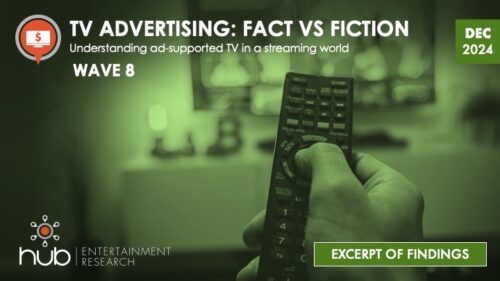
Understanding ad-supported TV in a streaming world
LEARN MOREOver the past few years, what would have once seemed unthinkable has become standard practice in the streaming video marketplace – virtually all subscription services have launched ad-supported offerings. As a result of formerly ad-free platforms like Netflix, Disney+, and Amazon Prime Video rolling out ad-supported tiers, and free ad-supported streamers (FASTs) grow their reach, the vast majority of viewers are now watching ads when they stream video.
The Hub TV Advertising: Facts vs. Fiction study has consistently shown viewers are receptive to advertising, particularly when it saves them money on subscriptions. With monthly rate increases on the horizon, are viewers becoming more open to ad-supported options? How does the changing advertising landscape impact perceptions of streaming services and the ad experiences they offer?
The goal of the study is to help streaming services, media agencies, advertisers, and distributors better understand how to present advertising that enhances viewers’ engagement and satisfaction with the streaming video experience.
Source: Interviews with 3,000 US TV Viewers age 14-74
Click here to subscribe to our free newsletter: Hub Intel
Get a Free Excerpt